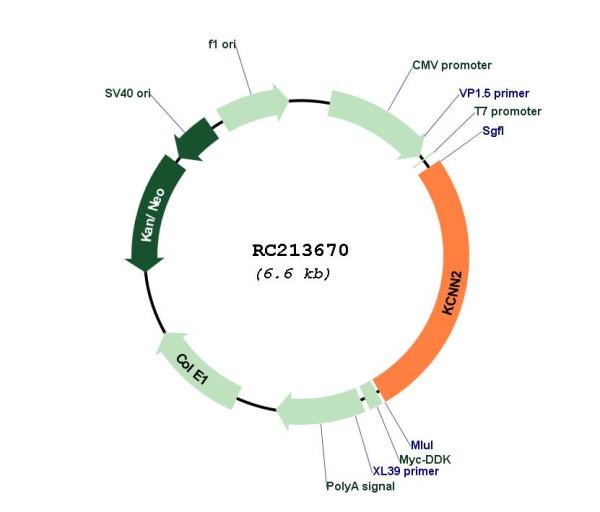KCNN2 (NM_021614) Human Tagged ORF Clone
CAT#: RC213670
KCNN2 (Myc-DDK-tagged)-Human potassium intermediate/small conductance calcium-activated channel, subfamily N, member 2 (KCNN2), transcript variant 1
ORF Plasmid: tGFP
Lentiviral Particles: DDK DDK w/ Puro mGFP mGFP w/ Puro
"NM_021614" in other vectors (6)
USD 198.00
Specifications
| Product Data | |
| Type | Human Tagged ORF Clone |
| Tag | Myc-DDK |
| Symbol | KCNN2 |
| Synonyms | hSK2; KCa2.2; SK2; SKCA2; SKCa 2 |
| Vector | pCMV6-Entry |
| E. coli Selection | Kanamycin (25 ug/mL) |
| Mammalian Cell Selection | Neomycin |
| Sequence Data |
>RC213670 ORF sequence
Red=Cloning site Blue=ORF Green=Tags(s) TTTTGTAATACGACTCACTATAGGGCGGCCGGGAATTCGTCGACTGGATCCGGTACCGAGGAGATCTGCC GCCGCGATCGCC ATGAGCAGCTGCAGGTACAACGGGGGCGTCATGCGGCCGCTCAGCAACTTGAGCGCGTCCCGCCGGAACC TGCACGAGATGGACTCAGAGGCGCAGCCCCTGCAGCCCCCCGCGTCTGTCGGAGGAGGTGGCGGCGCGTC CTCCCCGTCTGCAGCCGCTGCCGCCGCCGCCGCTGTTTCGTCCTCAGCCCCCGAGATCGTGGTGTCTAAG CCCGAGCACAACAACTCCAACAACCTGGCGCTCTATGGAACCGGCGGCGGAGGCAGCACTGGAGGAGGCG GCGGCGGTGGCGGGAGCGGGCACGGCAGCAGCAGTGGCACCAAGTCCAGCAAAAAGAAAAACCAGAACAT CGGCTACAAGCTGGGCCACCGGCGCGCCCTGTTCGAAAAGCGCAAGCGGCTCAGCGACTACGCGCTCATC TTCGGCATGTTCGGCATCGTGGTCATGGTCATCGAGACCGAGCTGTCGTGGGGCGCCTACGACAAGGCGT CGCTGTATTCCTTAGCTCTGAAATGCCTTATCAGTCTCTCCACGATCATCCTGCTCGGTCTGATCATCGT GTACCACGCCAGGGAAATACAGTTGTTCATGGTGGACAATGGAGCAGATGACTGGAGAATAGCCATGACT TATGAGCGTATTTTCTTCATCTGCTTGGAAATACTGGTGTGTGCTATTCATCCCATACCTGGGAATTATA CATTCACATGGACGGCCCGGCTTGCCTTCTCCTATGCCCCATCCACAACCACCGCTGATGTGGATATTAT TTTATCTATACCAATGTTCTTAAGACTCTATCTGATTGCCAGAGTCATGCTTTTACATAGCAAACTTTTC ACTGATGCCTCCTCTAGAAGCATTGGAGCACTTAATAAGATAAACTTCAATACACGTTTTGTTATGAAGA CTTTAATGACTATATGCCCAGGAACTGTACTCTTGGTTTTTAGTATCTCATTATGGATAATTGCCGCATG GACTGTCCGAGCTTGTGAAAGGTACCATGATCAACAGGATGTTACTAGCAACTTCCTTGGAGCGATGTGG TTGATATCAATAACTTTTCTCTCCATTGGTTATGGTGACATGGTACCTAACACATACTGTGGAAAAGGAG TCTGCTTACTTACTGGAATTATGGGTGCTGGTTGCACAGCCCTGGTGGTAGCTGTAGTGGCAAGGAAGCT AGAACTTACCAAAGCAGAAAAACACGTGCACAATTTCATGATGGATACTCAGCTGACTAAAAGAGTAAAA AATGCAGCTGCCAATGTACTCAGGGAAACATGGCTAATTTACAAAAATACAAAGCTAGTGAAAAAGATAG ATCATGCAAAAGTAAGAAAACATCAACGAAAATTCCTGCAAGCTATTCATCAATTAAGAAGTGTAAAAAT GGAGCAGAGGAAACTGAATGACCAAGCAAACACTTTGGTGGACTTGGCAAAGACCCAGAACATCATGTAT GATATGATTTCTGACTTAAACGAAAGGAGTGAAGACTTCGAGAAGAGGATTGTTACCCTGGAAACAAAAC TAGAGACTTTGATTGGTAGCATCCACGCCCTCCCTGGGCTCATAAGCCAGACCATCAGGCAGCAGCAGAG AGATTTCATTGAGGCTCAGATGGAGAGCTACGACAAGCACGTCACTTACAATGCTGAGCGGTCCCGGTCC TCGTCCAGGAGGCGGCGGTCCTCTTCCACAGCACCACCAACTTCATCAGAGAGTAGC ACGCGTACGCGGCCGCTCGAGCAGAAACTCATCTCAGAAGAGGATCTGGCAGCAAATGATATCCTGGATT ACAAGGATGACGACGATAAGGTTTAA >RC213670 protein sequence
Red=Cloning site Green=Tags(s) MSSCRYNGGVMRPLSNLSASRRNLHEMDSEAQPLQPPASVGGGGGASSPSAAAAAAAAVSSSAPEIVVSK PEHNNSNNLALYGTGGGGSTGGGGGGGGSGHGSSSGTKSSKKKNQNIGYKLGHRRALFEKRKRLSDYALI FGMFGIVVMVIETELSWGAYDKASLYSLALKCLISLSTIILLGLIIVYHAREIQLFMVDNGADDWRIAMT YERIFFICLEILVCAIHPIPGNYTFTWTARLAFSYAPSTTTADVDIILSIPMFLRLYLIARVMLLHSKLF TDASSRSIGALNKINFNTRFVMKTLMTICPGTVLLVFSISLWIIAAWTVRACERYHDQQDVTSNFLGAMW LISITFLSIGYGDMVPNTYCGKGVCLLTGIMGAGCTALVVAVVARKLELTKAEKHVHNFMMDTQLTKRVK NAAANVLRETWLIYKNTKLVKKIDHAKVRKHQRKFLQAIHQLRSVKMEQRKLNDQANTLVDLAKTQNIMY DMISDLNERSEDFEKRIVTLETKLETLIGSIHALPGLISQTIRQQQRDFIEAQMESYDKHVTYNAERSRS SSRRRRSSSTAPPTSSESS TRTRPLEQKLISEEDLAANDILDYKDDDDKV |
| Chromatograms |
CHROMATOGRAMS
 Sequencher program is needed, download here. |
| Restriction Sites |
SgfI-MluI
Cloning Scheme for this gene
Plasmid Map

|
| ACCN | NM_021614 |
| ORF Size | 1737 bp |
| OTI Disclaimer | Due to the inherent nature of this plasmid, standard methods to replicate additional amounts of DNA in E. coli are highly likely to result in mutations and/or rearrangements. Therefore, OriGene does not guarantee the capability to replicate this plasmid DNA. Additional amounts of DNA can be purchased from OriGene with batch-specific, full-sequence verification at a reduced cost. Please contact our customer care team at custsupport@origene.com or by calling 301.340.3188 option 3 for pricing and delivery. The molecular sequence of this clone aligns with the gene accession number as a point of reference only. However, individual transcript sequences of the same gene can differ through naturally occurring variations (e.g. polymorphisms), each with its own valid existence. This clone is substantially in agreement with the reference, but a complete review of all prevailing variants is recommended prior to use. More info |
| OTI Annotation | This clone was engineered to express the complete ORF with an expression tag. Expression varies depending on the nature of the gene. |
| Product Components | The ORF clone is ion-exchange column purified and shipped in a 2D barcoded Matrix tube containing 10ug of transfection-ready, dried plasmid DNA (reconstitute with 100 ul of water). |
| Reconstitution | 1. Centrifuge at 5,000xg for 5min. 2. Carefully open the tube and add 100ul of sterile water to dissolve the DNA. 3. Close the tube and incubate for 10 minutes at room temperature. 4. Briefly vortex the tube and then do a quick spin (less than 5000xg) to concentrate the liquid at the bottom. 5. Store the suspended plasmid at -20°C. The DNA is stable for at least one year from date of shipping when stored at -20°C. |
| Reference Data | |
| RefSeq | NM_021614.3, NP_067627.2 |
| RefSeq Size | 2531 bp |
| RefSeq ORF | 2376 bp |
| Locus ID | 3781 |
| UniProt ID | Q9H2S1 |
| Cytogenetics | 5q22.3 |
| Domains | SK_channel, CaMBD |
| Protein Families | Druggable Genome, Ion Channels: Potassium, Transmembrane |
| MW | 63.8 kDa |
| Gene Summary | Action potentials in vertebrate neurons are followed by an afterhyperpolarization (AHP) that may persist for several seconds and may have profound consequences for the firing pattern of the neuron. Each component of the AHP is kinetically distinct and is mediated by different calcium-activated potassium channels. The protein encoded by this gene is activated before membrane hyperpolarization and is thought to regulate neuronal excitability by contributing to the slow component of synaptic AHP. This gene is a member of the KCNN family of potassium channel genes. The encoded protein is an integral membrane protein that forms a voltage-independent calcium-activated channel with three other calmodulin-binding subunits. Alternate splicing of this gene results in multiple transcript variants. [provided by RefSeq, May 2013] |
Documents
| Product Manuals |
| FAQs |
| SDS |
Resources
Other Versions
| SKU | Description | Size | Price |
|---|---|---|---|
| RC213670L1 | Lenti ORF clone of Human potassium intermediate/small conductance calcium-activated channel, subfamily N, member 2 (KCNN2), transcript variant 1, Myc-DDK-tagged |
USD 1,108.00 |
|
| RC213670L2 | Lenti ORF clone of Human potassium intermediate/small conductance calcium-activated channel, subfamily N, member 2 (KCNN2), transcript variant 1, mGFP tagged |
USD 1,108.00 |
|
| RC213670L3 | Lenti ORF clone of Human potassium intermediate/small conductance calcium-activated channel, subfamily N, member 2 (KCNN2), transcript variant 1, Myc-DDK-tagged |
USD 1,108.00 |
|
| RC213670L4 | Lenti ORF clone of Human potassium intermediate/small conductance calcium-activated channel, subfamily N, member 2 (KCNN2), transcript variant 1, mGFP tagged |
USD 1,108.00 |
|
| RG213670 | KCNN2 (tGFP-tagged) - Human potassium intermediate/small conductance calcium-activated channel, subfamily N, member 2 (KCNN2), transcript variant 1 |
USD 1,008.00 |
|
| SC310251 | KCNN2 (untagged)-Human potassium intermediate/small conductance calcium-activated channel, subfamily N, member 2 (KCNN2), transcript variant 1 |
USD 810.00 |
{0} Product Review(s)
Be the first one to submit a review






























































































































































































































































 Germany
Germany
 Japan
Japan
 United Kingdom
United Kingdom
 China
China




